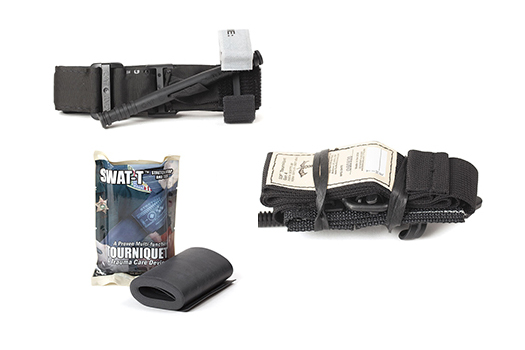^ For me, it's not so much about gunshots - it's more about the other dangers of everyday life. Motor-vehicle collisions are actually my biggest worry, followed by everyday kitchen mishaps.
It's the close-call of a motorcyclist acquaintance (who was only saved because a trauma nurse happened to be passing by, on her way home off-shift...finding him in a ditch and then literally pinching off a lacerated artery in his arm until the helicopter arrived) that really first pushed me to examine where and how I carried my EDC-medical.
Similarly, it's looking at the mass-casualty data as well as interpersonal-violence stats that first convinced me that I should really be carrying a couple of chest-seals (which my teenage daughter commented on, after seeing the recent video of the Officer Ronald Kennedy of the NYPD save a stabbing victim with a chip bag and duct-tape.
I wish there was a personal first aid kit the average Joe or Jane could carry as part of their EDC kit...without a huge pack.
Quick clot, along with a chest seal or two and a tourniquet covers a wide gambit of emergency situations.
Size is relative, and there's options....but as you very astutely noted, it will demand some sacrifice in terms of both getting ready for the day (time to situate gear), as well as in terms of carriage versus accessibility.
As EDC-medical went mainstream this past half-decade, so has the available options.
Defense Mechanisms, PHLster, Safer Faster Defense, Rkyer Nylon Gear, Dynamis/AdaptivX, Immediate Casualty Care, and a host of others offer more specialized equipment (like PHLster's "Flatpack") and or setups (from the now-common "ankle rigs" that many of the mentioned makers sell to the more specialized IWB rigs from Immediate Casualty Care or AdaptivX's) to help concealed-carriers increase their capabilities while maintaining discretion.
For those with more space -whether it be true "always carry," such as a woman's purse or a unisex hiking pack or for those who "mostly" keep a bag accessible, such as students' book-bags or a professional's briefcase, slightly larger kits such as the "mini" offerings from Blue Force Gear "Micro Trauma Kit NOW!," Dark Angel Medical's "Pocket D.A.R.K Mini," or North American Rescue's "Mini-FAK" offer the possibility of increasing capabilities at the addition of just some extra bulk.
Again, it's definitely true that for everyday civilian concealed-carry, it's a bit of a compromise.
Personally, my goal is that I can't appear be carrying "extra gear," so what I carry needs to disappear into my typical everyday wardrobe of jeans under an un-tucked T-shirt (or, for dressier situations, the nowadays typical slacks/casual-pants [no, not things with 20 cargo pockets

] under an un-tucked, "dressy" collared pull-over or button-up; for more formal occasions that require either a sport-coat or dinner jacket, all these worries disappear!).
Going back to this thread:
https://www.thearmorylife.com/forum/threads/show-off-your-every-day-carry.177/page-2#post-9640
My concealed-carry IFAK is a combination "blow-out" kit for ballistic trauma and a practical everyday "boo-boo" kit.
The pouch is an Adventure Medical Kits "Trauma Pack Pro" (
https://www.adventuremedicalkits.co...al/trauma-pack-pro-with-quikclot-swat-t.html; ), but I've swapped the QuikClot sponge with a pack of Z-folded Combat Gauze and supplemented it with a pack of chest seals, and changed out the included gloves for a tougher pair, keeping really only the SWAT-T (which can easily be used as everything from a pressure bandage to splinting material - and is also great for the back leg of my doggy friend) and the roll of duct-tape. Boo-boo wise, it's stocked with Moleskin, Band-Aids, and also contains a CountyComm titanium A/B Cache (
A/B Cache (Dual Compartment Capsule)) that holds one adult dose each: Advil, Tylenol, Benadryl, and Imodium, plus two $20 bills. In the years since I've started carrying med, the boo-boo kit has come in handy so many times, under so many different circumstances.
It's maybe 50% longer than my wallet, and about 25% thicker - exactly the girth of the OC canister next to it.
The pouch isn't bulletproof by any means, but I've been getting about 3 years' worth of "daily sit-on-my-butt use out of it, before it wears through (the A/B Cache is the hard-point that causes the bulk of the wear; I replaced it with a new one about two months after the cited post above, and that one was purchased in January, 2016). I keep this on my dominant side, back pocket. With my jeans and most pants, this allows for sufficient space to also stage the OC canister (Mk6 format) for proper deployment.
For me, staging the TQ in a concealable manner is actually the bigger compromise. I prefer the C-A-T, so I've standardized my family's emergency kits to it, in addition to my own medical gear for range/training. It's unfortunately quite a bit "less flat" than the SOFT-T that that fits so well in items like the PHLster "Flatpack" or the Lunar Concepts SwiftTQ Carrier. I actually thread the TQ as-pictured at the small of my back, under the belt. It's easily accessible for both hands, and deployable within appropriate time constraints - not as fast as from my range kit, but compromises.



